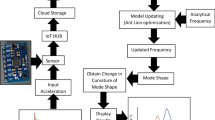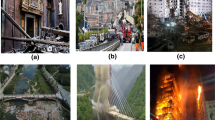Abstract
Currently, many countries are investing significantly in the maintenance of civil infrastructures, viewing them as valuable assets at the national and international levels. Based on the recorded dynamic response, Structural Health Monitoring (SHM) is in a position to ensure the performance and safety of such structures. SHM is currently focusing on the usage of Wireless Sensor Networks (WSN) for damage detection because it has proven to be the best substitute for traditional visual inspection and wired/tethered sensor networks. In SHM, live tracking the structural response anytime anywhere is a predominant challenge. This work proposed and implemented an end-to-end live structural health monitoring framework based on the Internet of Things (IoT) to prevent the structure from collapsing unexpectedly. Furthermore, IoT assists in the live monitoring of structures at any time and from any location. Accelerometer sensors (40), signal conditioners (40), Data Acquisition Cards with an integrated Wi-Fi/Ethernet module (10), Access Point (1), and other components are included in the proposed framework. The accelerometer sensors are utilized to record the structural response, which is then analyzed by proposed Artificial Intelligence (AI) methods to identify the incipient damage and localize the damage. The AI methods are established using two datasets: one from a three-story building frame designed and realized in our laboratory, and the other from Los Alamos laboratory’s three-story bookshelf structure. It is a unique framework that offers three user interfaces (standalone, web-based, and mobile-based) to enable live monitoring locally and globally. The results demonstrate very good damage identification and localization accuracy, as well as the ability to live-monitor via interfaces.






Similar content being viewed by others
Data availability
The datasets generated during and/or analyzed during the current study are available from the corresponding author on reasonable request.
References
Abdelgawad A, Yelamarthi K (2016) Structural health monitoring: internet of things application. In: 2016 IEEE 59th International Midwest Symposium on Circuits and Systems (MWSCAS). IEEE. p. 1–4
Abdelgawad A, Yelamarthi K (2017) Internet of things (IoT) platform for structure health monitoring. Wirel Commun Mob Comput 2017:1–10. https://doi.org/10.1155/2017/6560797
Anon (2021) SHM Data Sets and Software. Los Alamos National Laboratory. https://www.lanl.gov/projects/national-security-education-center/engineering/software/shm-data-sets-and-software.php. Accessed 28 Sep 2021
Arcadius Tokognon C, Gao B, Tian GY, Yan Y (2017) Structural health monitoring framework based on internet of things: a survey. IEEE Internet Things J 4(3):619–635. https://doi.org/10.1109/JIOT.2017.2664072
Bacco M, Barsocchi P, Cassara P, Germanese D, Gotta A, Leone GR, Moroni D, Pascali MA, Tampucci M (2020) Monitoring ancient buildings: real deployment of an IoT system enhanced by UAVs and virtual reality. IEEE Access 8:50131–50148. https://doi.org/10.1109/ACCESS.2020.2980359
Burrello A, Marchioni A, Brunelli D, Benatti S, Mangia M, Benini L (2021) Embedded streaming principal components analysis for network load reduction in structural health monitoring. IEEE Internet Things J 8(6):4433–4447. https://doi.org/10.1109/JIOT.2020.3027102
Capineri L, Bulletti A (2021) Ultrasonic guided-waves sensors and integrated structural health monitoring systems for impact detection and localization: a review. Sensors 21:22–38. https://doi.org/10.3390/s21092929
Fu X, Zhang X, Nadira L (2023) IoT-enabled wireless transmission system for structural health monitoring. Dalhousie University, Canada. Retrieved 27 May 2023, from https://cdn.dal.ca/content/dam/dalhousie/images/engineering/CapstoneConference/2019-projects/ECED01_11.pdf
Ibrahim A, Eltawil A, Na Y, El-Tawil S (2020a) A machine learning approach for structural health monitoring using noisy data sets. IEEE Trans Autom Sci Eng 17(2):900–908. https://doi.org/10.1109/TASE.2019.2950958
Ibrahim A, Eltawil A, Na Y, El-Tawil S (2020b) Effect of sensor error on the assessment of seismic building damage. IEEE Trans Instrum Meas 69(2):573–584. https://doi.org/10.1109/TIM.2019.2896371
Kim D, Jung J, Koo Y, Yi Y (2020) Bird-MAC: energy-efficient MAC for quasi-periodic IoT applications by avoiding early wake-up. IEEE Trans Mob Comput 19(4):788–802. https://doi.org/10.1109/TMC.2019.2899572
Lamonaca F, Olivito RS, Porzio S, Cami DL, Scuro C (2018) Structural Health Monitoring System for Masonry Historical Construction. In IEEE International Conference on Metrology for Archaeology and Cultural Heritage (MetroArchaeo). Cassino, Italy: IEEE. p. 330–35
Liu Q, Zhu Y, Yuan X, Zhang J, Rui Wu, Dou Q, Liu S (2020) Internet of things health detection system in steel structure construction management. IEEE Access 8:147162–147172. https://doi.org/10.1109/ACCESS.2020.3008916
Loubet G, Takacs A, Dragomirescu D (2019) Implementation of a battery-free wireless sensor for cyber-physical systems dedicated to structural health monitoring applications. IEEE Access 7:24679–24690. https://doi.org/10.1109/ACCESS.2019.2900161
Malekloo A, Ozer E, AlHamaydeh M, Girolami M (2021) Machine learning and structural health monitoring overview with emerging technology and high-dimensional data source highlights. Struct Health Monit. https://doi.org/10.1177/14759217211036880
Malekloo A, Ozer E, AlHamaydeh M, Girolami M (2022) Machine learning and structural health monitoring overview with emerging technology and high-dimensional data source highlights. Struct Health Monit 21(4):1906–1955. https://doi.org/10.1177/14759217211036880
Misra D, Das G, Das D (2020) An IoT based building health monitoring system supported by cloud. J Reliab Intell Environ 6:141–152. https://doi.org/10.1007/s40860-020-00107-0
Muttillo M, Stornelli V, Alaggio R, Paolucci R, Di Battista L, de Rubeis T, Ferri G (2020) Structural health monitoring: an IoT sensor system for structural damage indicator evaluation. Sensors 20:1–15. https://doi.org/10.3390/s20174908
Ng A (2021) “Machine Learning—Andrew Ng, Stanford University.” Artificial —All in One. https://www.youtube.com/watch?v=PPLop4L2eGk&list=PLLssT5z_DsK-h9vYZkQkYNWcItqhlRJLN. Accessed 28 Sept 2021
Nord JH, Koohang A, Paliszkiewicz J (2019) The internet of things: review and theoretical framework. Expert Syst Appl 133:97–108. https://doi.org/10.1016/j.eswa.2019.05.014
Nuzzo Di, Flavio DB, Polonelli T, Benini L (2021) Structural Health monitoring system with narrowband IoT and MEMS sensors. IEEE Sens J 21(14):16371–16380. https://doi.org/10.1109/JSEN.2021.3075093
Pan Y, Ma Y, Dong Y, Zhenxiong Gu, Wang D (2021) a vision-based monitoring method for the looseness of high-strength bolt. IEEE Trans Instrum Meas 70:1–14. https://doi.org/10.1109/TIM.2021.3101316
Scuro C, Sciammarella PF, Lamonaca F, Olivito RS, Carni DL (2018) IoT for structural health monitoring. IEEE Instrum Meas Mag 21(6):4–14. https://doi.org/10.1109/MIM.2018.8573586
Scuro C, Lamonaca F, Porzio S, Milani G, Olivito RS (2021) Internet of things (IoT) for masonry structural health monitoring (SHM): overview and examples of innovative systems. Constr Build Mater 290:1–22. https://doi.org/10.1016/j.conbuildmat.2021.123092
Sidorov M, Nhut PV, Matsumoto Y, Ohmura R (2019) LoRa-based precision wireless structural health monitoring system for bolted joints in a smart city environment. IEEE Access 7:179235–179251. https://doi.org/10.1109/ACCESS.2019.2958835
Sidorov M, Khor JH, Nhut PV, Matsumoto Y, Ohmura R (2020) A public blockchain-enabled wireless LoRa sensor node for easy continuous unattended health monitoring of bolted joints: implementation and evaluation. IEEE Sens J 20(21):13057–13065. https://doi.org/10.1109/JSEN.2020.3001870
Wang C, Han F, Zhang Y, Jingyi Lu (2020) An SAE-based resampling SVM ensemble learning paradigm for pipeline leakage detection. Neurocomputing 403:237–246. https://doi.org/10.1016/j.neucom.2020.04.105
Wang D, Ren B, Cui Bo, Wang J, Wang X, Guan T (2021) Real-time monitoring for vibration quality of fresh concrete using convolutional neural networks and IoT technology. Autom Constr 123:1–15. https://doi.org/10.1016/j.autcon.2020.103510
Yi L, Deng X, Yang LT, Hengshan Wu, Wang M, Situ Yi (2021) Reinforcement-learning-enabled partial confident information coverage for IoT-based bridge structural health monitoring. IEEE Internet Things J 8(5):3108–3119. https://doi.org/10.1109/JIOT.2020.3028325
Zhang L, Zhou G, Han Y, Lin H, Yuying Wu (2018) Application of internet of things technology and convolutional neural network model in bridge crack detection. IEEE Access 6:39442–39451. https://doi.org/10.1109/ACCESS.2018.2855144
Zinno R, Haghshenas SS, Guido G, VItale A (2022) Artificial intelligence and structural health monitoring of bridges: a review of the state-of-the-art. IEEE Access 10:88058–78. https://doi.org/10.1109/ACCESS.2022.3199443
Zonzini F, Aguzzi C, Gigli L, Sciullo L, Testoni N, De Marchi L, Di Felice M, Cinotti TS, Mennuti C, Marzani A (2020) Structural health monitoring and prognostic of industrial plants and civil structures: a sensor to cloud architecture. IEEE Instrum Meas Mag 23(9):21–27. https://doi.org/10.1109/MIM.2020.9289069
Author information
Authors and Affiliations
Corresponding author
Ethics declarations
Conflict of interest
The authors declare that they have no conflict of interest.
Additional information
Publisher's Note
Springer Nature remains neutral with regard to jurisdictional claims in published maps and institutional affiliations.
Rights and permissions
Springer Nature or its licensor (e.g. a society or other partner) holds exclusive rights to this article under a publishing agreement with the author(s) or other rightsholder(s); author self-archiving of the accepted manuscript version of this article is solely governed by the terms of such publishing agreement and applicable law.
About this article
Cite this article
Kumar, P., Kota, S.R. IoT enabled diagnosis and prognosis framework for structural health monitoring. J Ambient Intell Human Comput 14, 11301–11318 (2023). https://doi.org/10.1007/s12652-023-04646-1
Received:
Accepted:
Published:
Issue Date:
DOI: https://doi.org/10.1007/s12652-023-04646-1




